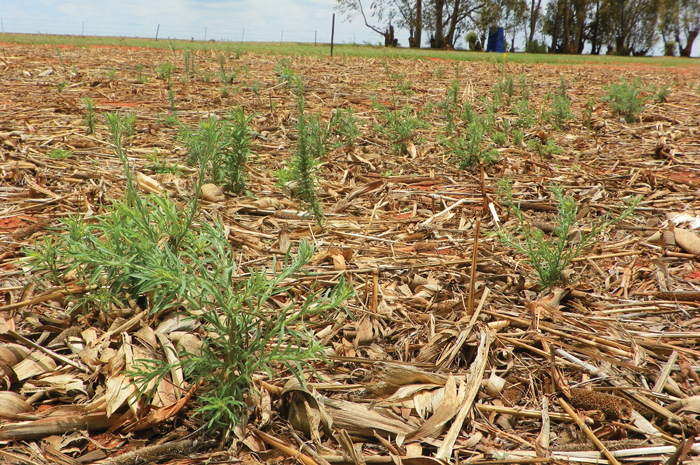On 26 June, Grain SA held an engaging Weed Science Day, bringing together a diverse group of participants including chemical industry experts, researchers, government officials, and producers. This collaborative gathering was dedicated to tackling pressing weed management challenges through innovative and cooperative strategies.
Rising challenges concerning weeds loom over the grain industry as weeds such as Amaranthus, Lolium, and Conyza species are evolving, defying traditional control methods with increasing herbicide resistance. The goal of the Weed Science Day was to identify key areas of concern, assess current measures being taken and explore new strategies. The day highlighted a growing challenge with herbicide resistance and underscored the need for increased awareness raising and continuous communication, as well as robust evaluation and monitoring. Alongside this, the current lack of capacity in weed science demands immediate intervention. Stronger collaborations and more frequent engagements between researchers, industry, and government were identified as essential for addressing these challenges effectively.
Current weed issues facing the grain industry in summer regions
In the summer grain region, the major challenge identified was the prevalence of Amaranthus and Conyza, which are suspected of developing resistance to herbicides such as glyphosate. A need was raised for more information on the distribution and occurrence of weed species in the summer grain region, and surveys can positively impact research priorities and initiatives. An urgent need was highlighted for effective weed management strategies to keep farm productivity high and minimise economic losses from reduced crop yields and poor quality.
Current weed issues facing the grain industry in winter regions
Ryegrass emerged as the primary concern among producers in the Western Cape. Their lightweight seeds can travel long distances, leading to widespread distribution and rapid colonisation of fields. This dispersal mechanism accelerates the development of herbicide resistance, complicating weed management efforts. This is compounded by limited chemical options due to high registration costs. Research is being conducted on integrated strategies (e.g., crop rotation, chemical management, and planting density) to manage ryegrass populations.

Photo: Dr Maryke Craven

Photo: Prof Juan Vorster
Herbicide resistance
There has been a global rise in unique cases of herbicide resistance and South Africa is no exception. The South African Herbicide Research Initiative (SAHRI) was established following the first detection of Amaranthus palmeri in South Africa and has since been screening for herbicide resistance in A. palmeri and A. hybridus. SAHRI’s screenings revealed that A. hybridus poses a significant threat to crop production due to increasing herbicide resistance build-up and its distribution across the country. In screening palmer populations, varying glyphosate susceptibility as well as resistance to other chemicals were noted; revealing no one-size-fits-all solution and emphasising the need for continuous monitoring. In addition to SAHRI, researchers at the Agricultural Research Council and Stellenbosch University are conducting herbicide resistance monitoring. Diagnostic facilities and capacity are vital for identifying weeds and assessing herbicide resistance.
Efforts to combat herbicide resistance in South Africa’s grain industry, particularly within the summer grain production area, are paramount for ensuring sustainable agricultural practices. A comprehensive understanding of weed ecology and biology is essential to developing effective management strategies that can mitigate this growing threat. The industry is urged to actively support scientific initiatives, as their backing is crucial for maintaining focus on priority research areas.

Photo: Robin Riet

Photo: Nolo Bakwa
Current and future management strategies
Herbicides have long been regarded as the silver bullet for weed management, yet rising resistance to key active ingredients is undermining their viability. Moreover, the effective application of herbicides remains a challenge due to factors such as wind, timing, and temperature.
An integrated weed management approach is essential to cost-effective management of the seed bank. This should include incorporating:
- crop rotation;
- competitive crops;
- livestock;
- cover crops;
- row spacing; and
- precision technologies.
Ultimately, it’s crucial to accept that fields will never be completely weed-free; the focus should be on managing weed populations effectively and balancing the costs of control against the damage caused by weeds.
Future directions
Effective weed management is essential for achieving high yields and maintaining crop quality. Technological advancements in weed control have been instrumental in enhancing agricultural productivity over time. While herbicides have traditionally been a straightforward and cost-efficient method for weed management, their effectiveness is declining as herbicide-resistant weeds become more prevalent. This highlights the urgent need for cost-effective and sustainable weed management strategies to control herbicide-resistant weed populations through diverse, integrated practices.
The following initiatives are crucial for industry, government, and the research community to address jointly in order to develop innovative, cost-effective, and sustainable weed management approaches:
- Enhanced surveillance: Improve diagnostic capabilities and early detection methods.
- Institutional capacity and training: Build capacity and enhance training.
- Integrated management practices: Develop and implement diverse management strategies that are environmentally sustainable.
- Awareness raising: Raise awareness of integrated management practices and effective herbicide use.
- Collaborative synergy: Foster collaboration among government bodies, industry, producers, and researchers.
- Strengthened research: Focus on weed biology, genetics, and management strategies.
Contact Dr Lavinia Kisten at 083 273 0709 or lavinia@grainsa.co.za or Pfano Musetsho at 065 887 7946 or pfano@grainsa.co.za to get in touch with the research community for advice or resistance screening.

















